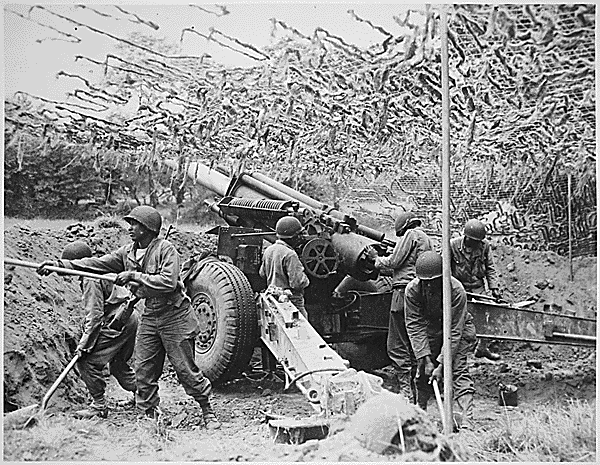An American 155mm howitzer being emplaced in France - June 28, 1944
Even though many regard the Red Army as the Second World War's chief artillery proponent, this perception has mostly stemmed from the Soviet propensity to mass sheer numbers of gun tubes to produce devastating concentrations of firepower (which did improve in accuracy and efficacy as the War entered its final years). In truth, the Americans, although like the Red Army in frequently launching massive displays of firepower, unlike the Soviets; consistently, flexibly and accurately called down effective artillery support at will throughout the War - even when on the move. In part for reasons such as these, the US Army finished the Second World War with what was widely regarded as the War's qualitatively best artillery arm.
The explanation for the American artillery arm's lethal efficacy stemmed from a number of reasons. First, and perhaps primarily, was the world-class fire control system developed by the US Army. Well-trained and skilled forward observers proved the linchpin to this fire control system, and were integral to nearly every American combat unit. In addition, US Army forward observers could rely on excellent communications technology helping to ensure the constant availability of massive firepower concentrations for other US combat arms to rely upon.
Second, American gunners honed particularly lethal tactics. The Time on Target (TOT) ranked as a favorite and devastating use of ground based indirect weapons. The TOT required American artillery batteries to coordinate and target every available gun to fire simultaneously at a specified target. If the proper coordination could be achieved the full barrage would arrive on target at the same moment; this produced a devastating impact upon those on the receiving end of such a barrage. For example, on one occasion during the fall 1944 fighting in France, American infantry assaulting a German position called in a fire mission from the Third Army's XX Corps fire direction center. Within just six minutes the Corps' artillery received the fire mission, assigned an artillery battalion to the requested target, and blasted the target with 67 rounds. (The Lorraine Campaign: An Overview, September-December 1944, Dr. Christopher R. Gabel, United States Army Command and General Staff College Fort Leavenworth Kansas 1985 at page 11). Additonal American tactics including employing barrages featuring white phosphorous and variable fuse (VT) shells. VT shells possessed small radars detecting the approaching ground in flight; prematurely detonating the artillery shell in the air above the target and spraying it with deadly shrapnel - such a shell exploding above often butchered Axis soldiers taking cover in conventional foxholes.
American artillery officers could rely on more than sound doctrine and tactics. Technically, American artillery pieces ranked amongst the best in the world; providing a third reason for American superiority on the battlefield. The M1 105mm howitzer and M1 155mm howitzer proved incredibly accurate at long ranges. For even heavier firepower the Americans deployed the M1 240mm howitzer; more potent than any gun in the German inventory; with a more powerful shell than even the German heavy 170mm artillery piece. A fourth and final reason only further enhancing American artillery's effectiveness was its mobility; every artillery piece was either truck pulled, or mounted as self-propelled weapons.
In a testimonial to the efficacy displayed by American artillery the German soldier, often singled out as perhaps the all round best combat soldier during the War, particularly feared American artillery fire. German soldiers who fought against both the Russians and Americans almost unanimously agreed American ranked as the deadliest in the world.
Picture Courtesy US National Archives, ARC identifier no. 531198


